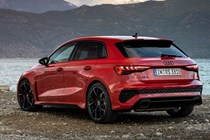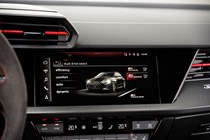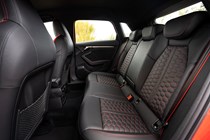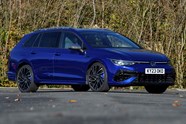Audi A3 RS 3 Sportback review
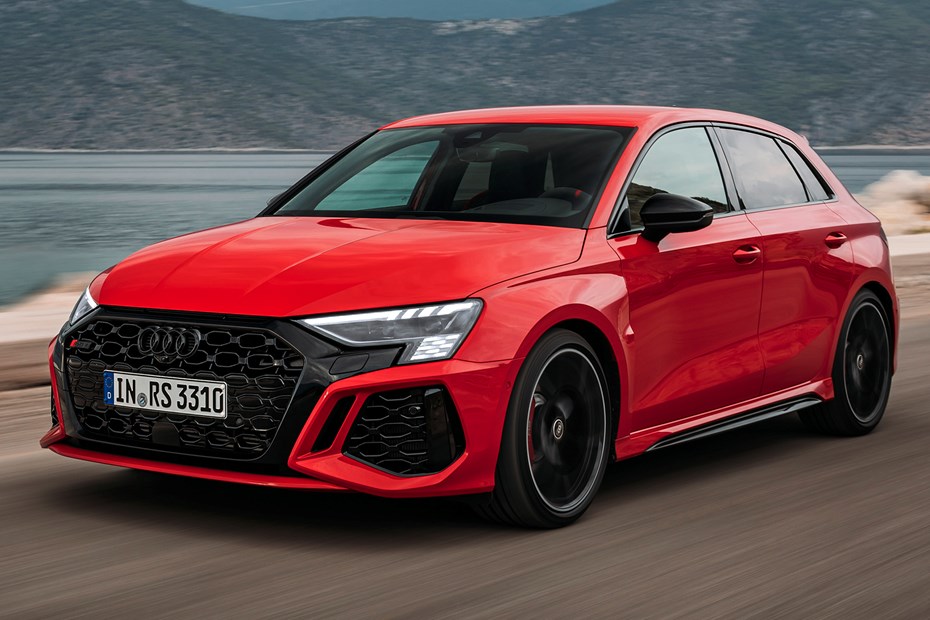
At a glance
| Price new | £54,450 - £61,700 |
|---|---|
| Used prices | £38,350 - £57,065 |
| Road tax cost | £600 |
| Insurance group | 35 - 40 |
Get an insurance quote with

|
|
| Fuel economy | 31 - 31.4 mpg |
| Miles per pound | 4.5 - 4.6 |
| View full specs for a specific version | |
Available fuel types
Petrol
Pros & cons
- Great engine – powerful and sounds charismatic
- Agile and surprisingly comfortable
- High-quality interior
- Expensive to buy, pricey options
- Firm fide, even in Comfort mode
- Volkswagen Golf R makes more sense
Audi A3 RS 3 Sportback rivals
Overview
This is the third-generation Audi RS 3, the all-wheel-drive, all-powerful super-hatch. Well, hatch and small saloon. It’s available in the UK as a five-door hatchback (which Audi calls the RS 3 Sportback), or as a four-door RS 3 Saloon.
Natural all-wheel-drive performance car rivals include the similarly pricey Mercedes-AMG A45 and the marginally more affordable BMW M135i xDrive hatch and M235i xDrive saloon.
There’s also the Volkswagen Golf R, with which the Audi RS 3 shares some of its technical components and basic structure. The Audi is pricier, posher and, as it turns out, more agile too.
Technical highlights
As before, the RS 3 is powered by a 2.5-litre, five-cylinder engine. New control software has allowed higher turbo boost for greater power and greater torque, both of which are available from lower revs and maintain their peak for longer. The only gearbox available is a seven-speed twin-clutch auto.
New for the RS 3 is a Torque Splitter system at the rear axle, which replaces a conventional differential. Electronically controlled clutches at either side control how much torque is sent to each rear wheel. Ordinarily, more torque is pooled to the outside wheel, helping the RS 3 to turn more positively. In slippery conditions, if the system detects the car beginning to slide at the rear, it can bundle torque to the inside wheel to help pull the car straight.
It’s a similar system to that of the Volkswagen Golf R, but Audi’s control software is said to be more sophisticated and makes the car feel more agile in practice. It can also allow for power slides on closed circuits away from the public road, by applying 100% of the rear axle’s torque to the outside wheel – but this is best tried somewhere with lots of space, and by a driver with lots of spare cash for replacement tyres.
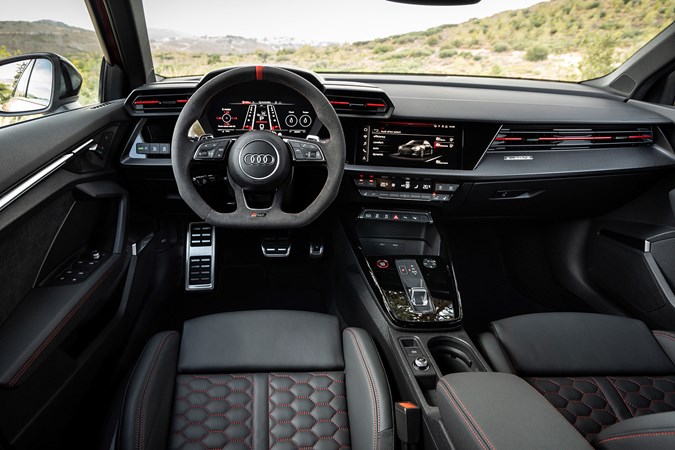
What’s it like inside?
Overall, the A3’s cabin is not quite as impressive looking as the A-Class, perhaps, but is better than the BMW 1 Series, and is by far one of the best interiors that Audi has turned out for some time. The driver’s seat is supportive and looks fantastic.
Audi’s reputation for quality continues here. It’s a roomy cabin that’s plush and well-trimmed in the highest-quality materials. It gets a large and crisp-looking 10.25-inch touchscreen, which integrates beautifully with the RS 3’s digital Virtual Cockpit.
The infotainment system is bang-up-to-date and will even remember the profiles of up to six drivers, so the car will store your preferred sat-nav destinations, seat position and even air-con preferences. Buyers can also choose to upgrade to a larger 12.3-inch screen. In short, it’s the premium experience you’d expect at this price.
What’s it like to drive?
So far we’ve tested the RS 3 only with adaptive dampers and it rides impressively well at low speeds and when pressing on. On motorways at a cruise the ride can feel a little firmer at times, even in Comfort mode.
Even with the sport exhaust system the RS 3 isn’t quite as vocal as you might expect, despite new fully variable flaps in the exhaust to control how quiet or otherwise the engine note becomes. Nonetheless, the 2.5-litre five-cylinder is still one of the most distinctive and memorable-sounding engines on sale today. It’s certainly quick, too.
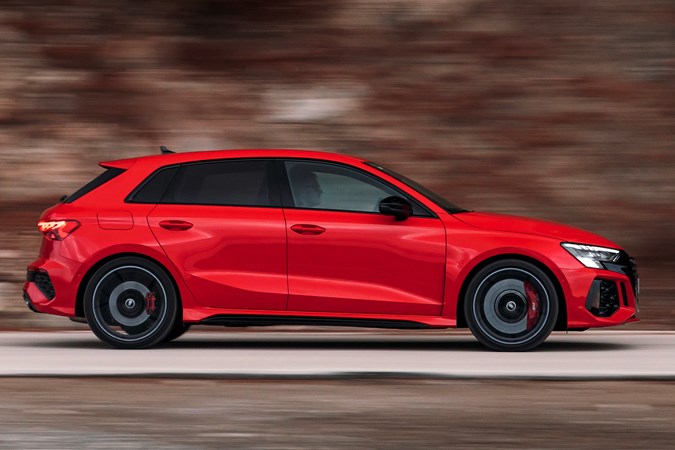
Compared with some all-wheel-drive performance cars, the 2021 Audi RS 3 feels more agile and positive, and its handling balance doesn’t tend towards understeer. This is thanks largely to the Torque Splitter, which helps to make the RS 3 feel positive and engaged at all times. It’s very grippy and gives the driver a lot of confidence.
The steering is very quick-reacting, without being over-sensitive, and allows you to keep your hands in one position on the wheel for tight corners. Like many wide-tyred hot hatches, however, the RS 3’s broad turning circle is worse than bigger saloon cars.
The optional ceramic brakes can feel a little grabby until you’re used to them but they have plenty of stopping power, and staying power too – Audi’s research has suggested more RS 3 customers than it had thought are using their cars on trackdays, and the ceramic brakes have been designed to withstand multiple hard laps at the Nurburgring circuit in Germany without fading.
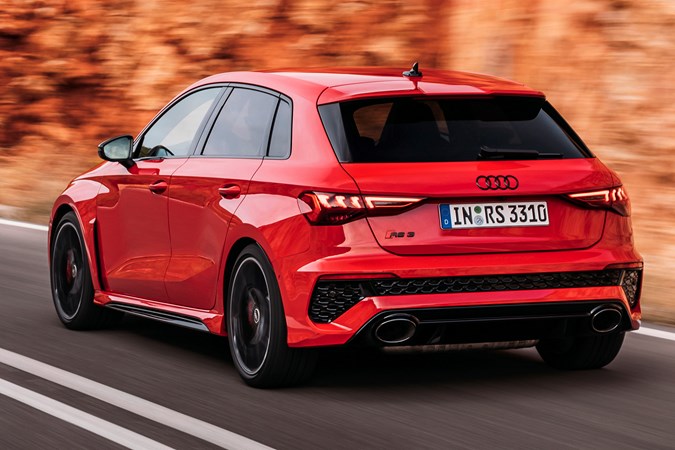
What models and trims are available?
- Audi RS 3: The base trim with heated leather seats, cruise control, climate control and the Audi Sport logo projected onto the ground when the doors open
- Audi RS 3 Carbon Black: Adds sport exhaust system, Matrix LED headlights, black roof, various other bits of gloss black and carbon exterior trim, different wheel designs
- Audi RS 3 Vorsprung: Bang and Olufsen stereo, adaptive cruise control, reversing camera, wireless phone charging, head-up display, 360-degree cameras Despite its high price, Audi expects more than half of UK buyers to choose the Vorsprung level.
A key option is the RS Dynamic Pack, which fits electronically controlled adaptive dampers and lighter ceramic brakes. Less relevantly, it also removes the 155mph speed limiter allowing 180mph if you can find the space. There’s a noisier sport exhaust system too.
At 1,575kg, the Saloon weighs only 5kg more than the Sportback. It costs £1,000 extra, and packs a mite less headroom for rear passengers and without the hatchback tailgate, a less accessible luggage space. It’s still a practical car, however, especially with the 40:20:40-split rear seats folded flat.



